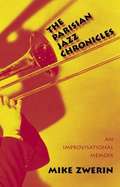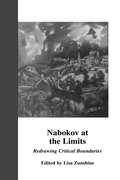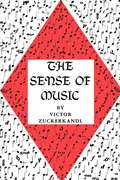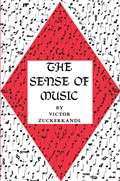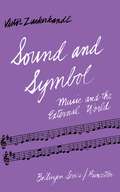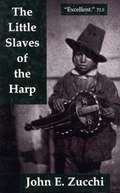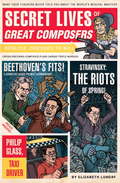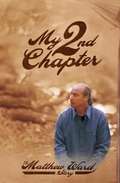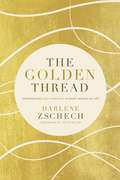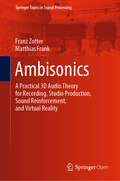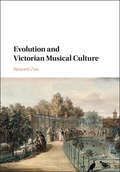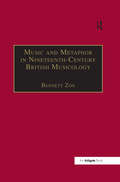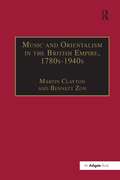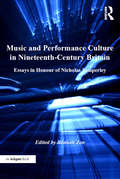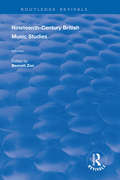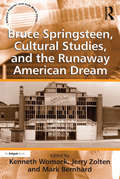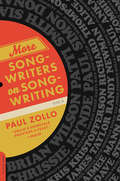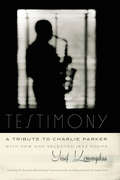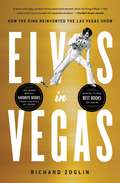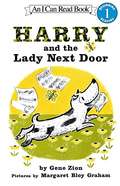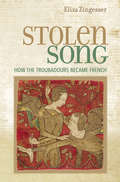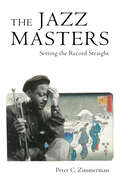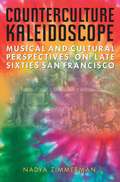- Table View
- List View
Will You Miss Me When I'm Gone: The Carter Family and their Legacy in American Music
by Mark Zwonitzer Charles HirshbergThe Parisian Jazz Chronicles: An Improvisational Memoir
by Mike ZwerinThis book is built around a structure that treats such subjects of my music column in the International Herald Tribune as Dexter Gordon, Freddy Heineken, Miles Davis, Bob Dylan, Chet Baker, and Melvin Van Peebles as though they were the written notes in big band arrangements.
Nabokov at the Limits: Redrawing Critical Boundaries (Border Crossings)
by Lisa ZunshineThe eleven contributors to this volume investigate the connections between Nabokov's output and the fields of painting, music, and ballet.
The Sense of Music
by Victor ZuckerkandlThis book is addressed to the listener whose enjoyment of music is filled with questions and whose curiosity makes him eager to grasp the sense of music, despite a lack of theoretical training. Unlike the usual listener's guide, which begins with a discussion of the elementary materials of music, this book starts with the elementary experiences of listening.
The Sense of Music
by Victor ZuckerkandlThis book is addressed to the listener whose enjoyment of music is filled with questions and whose curiosity makes him eager to grasp the sense of music, despite a lack of theoretical training. Unlike the usual listener's guide, which begins with a discussion of the elementary materials of music, this book starts with the elementary experiences of listening.
Sound and Symbol, Volume 1: Music and the External World (Bollingen Series (General) #655)
by Victor ZuckerkandlAn approach to music as an instrument of philosophical inquiry, seeking not so much a philosophy of music as a philosophy through music.
The Little Slaves of the Harp: Italian Child Street Musicians in Nineteenth-Century Paris, London, and New York (McGill-Queen's Studies in Ethnic History #13)
by John E. ZucchiDuring the nineteenth century child musicians could be seen performing in the streets of cities across Europe and North America. Although they came from a number of countries, Italians were most associated with street music. In The Little Slaves of the Harp John Zucchi tells the story of the thousands of Italian children who were indentured to padrone and then uprooted from their villages in central and southern Italy and taken to Paris, London, and New York to perform as barrel-organists, harpists, violinists, fifers, pipers, and animal exhibitors.
Secret Lives of Great Composers
by Mario Zucca Elizabeth LundayTrue tales of murder, riots, heartbreak, and great music. With outrageous anecdotes about everyone from Gioachino Rossini (draft-dodging womanizer) to Johann Sebastian Bach (jailbird) to Richard Wagner (alleged cross-dresser), Secret Lives of Great Composers recounts the seamy, steamy, and gritty history behind the great masters of international music. You'll learn that Edward Elgar dabbled with explosives; that John Cage was obsessed with fungus; that Berlioz plotted murder; and that Giacomo Puccini stole his church's organ pipes and sold them as scrap metal so he could buy cigarettes. This is one music history lesson you'll never forget!
My 2nd Chapter: The Matthew Ward Story
by Darlene ZschedhHow one family's tragedy ultimately revolutionized contemporary Christian music. Known for such classics as "Easter Song," the Second Chapter of Acts was one of the major music groups in the forefront of the Jesus movement. But what happened, in the wake of personal tragedy, to bring together a brother and his two sisters to sing so boldly for their Lord? And what was life really like for a major contemporary Christian band in those early days? In My Second Chapter, Matthew Ward tells his part of the storyfull of intriguing and humorous behind-the-scenes anecdotes and observations: growing up in a large family...orphaned at age twelve...finding the Lord in the California Jesus movement... becoming a music star...traveling the world...battling cancer...raising his own family ... and much more all revealing God's faithfulness in every circumstance. Join Matthew on his amazing personal journey from tragedy to dynamic faith that helped set contemporary Christian music on fire. And discover how God chooses whom he will to accomplish great and mighty acts.From the Trade Paperback edition.
The Golden Thread: Experiencing God’s Presence in Every Season of Life
by Darlene Zschech Joyce Meyer“I know your faith will be lifted and increased with this new treasure.”~Chris TomlinDo you feel like you are barely holding on?Let the golden thread of God's presence be the calm on the other side of chaos.It could be that He is weaving a brilliant new beginning in the middle of your mess.Join beloved worship leader Darlene Zschech as she traces God’s goodness through her recent transitions—moving to a new city, starting a church. The songwriter of “Shout to The Lord” urges us to maintain joy in the middle of it all.Rather than seeing her many life changes as a zigzag of unrelated events, Darlene and her family have learned to trace God’s goodness through every crisis—even as she faced the battle for her life, cancer.Your heart will be encouraged, and your faith will soar right along with Darlene’s.
Ambisonics: A Practical 3D Audio Theory for Recording, Studio Production, Sound Reinforcement, and Virtual Reality (Springer Topics in Signal Processing #19)
by Franz Zotter Matthias FrankThis open access book provides a concise explanation of the fundamentals and background of the surround sound recording and playback technology Ambisonics. It equips readers with the psychoacoustical, signal processing, acoustical, and mathematical knowledge needed to understand the inner workings of modern processing utilities, special equipment for recording, manipulation, and reproduction in the higher-order Ambisonic format. The book comes with various practical examples based on free software tools and open scientific data for reproducible research.The book’s introductory section offers a perspective on Ambisonics spanning from the origins of coincident recordings in the 1930s to the Ambisonic concepts of the 1970s, as well as classical ways of applying Ambisonics in first-order coincident sound scene recording and reproduction that have been practiced since the 1980s. As, from time to time, the underlying mathematics become quite involved, but should be comprehensive without sacrificing readability, the book includes an extensive mathematical appendix. The book offers readers a deeper understanding of Ambisonic technologies, and will especially benefit scientists, audio-system and audio-recording engineers.In the advanced sections of the book, fundamentals and modern techniques as higher-order Ambisonic decoding, 3D audio effects, and higher-order recording are explained. Those techniques are shown to be suitable to supply audience areas ranging from studio-sized to hundreds of listeners, or headphone-based playback, regardless whether it is live, interactive, or studio-produced 3D audio material.
Evolution and Victorian Musical Culture
by Bennett ZonThis engaging book explores the dynamic relationship between evolutionary science and musical culture in Victorian Britain, drawing upon a wealth of popular scientific and musical literature to contextualize evolutionary theories of the Darwinian and non-Darwinian revolutions. Bennett Zon uses musical culture to question the hegemonic role ascribed to Darwin by later thinkers, and interrogates the conceptual premise of modern debates in evolutionary musicology. Structured around the Great Chain of Being, chapters are organized by discipline in successively ascending order according to their object of study, from zoology and the study of animal music to theology and the music of God. Evolution and Victorian Musical Culture takes a non-Darwinian approach to the interpretation of Victorian scientific and musical interrelationships, debunking the idea that the arts had little influence on contemporary scientific ideas and, by probing the origins of musical interdisciplinarity, the volume shows how music helped ideas about evolution to evolve.
Music and Metaphor in Nineteenth-Century British Musicology (Music In Nineteenth-century Britain Ser.)
by Bennett Zon�In a word, I shall endeavour to show how our music, having been originally a shell-fish, with its restrictive skeleton on the outside and no soul within, has been developed by the inevitable laws of evolution, through natural selection and the survival of the fittest, into something human, even divine, with the strong, logical skeleton of its science inside, the fair flesh of God-given beauty outside, and the whole, like man himself, animated by a celestial, eternal spirit....� W.J. Henderson, The Story of Music (1889) Critical writing about music and music history in nineteenth-century Britain was permeated with metaphor and analogy. Music and Metaphor examines how over-arching theories of music history were affected by reference to various figurative linguistic templates adopted from other disciplines such as art, religion, politics and science. Each section of the book discusses a wide range of musicological writings and their correspondence with the language used to convey contemporary ideas such as the sublime, the ancient and modern debate, and, in particular, the theory of evolution. Bennett Zon reveals that through their application of metaphorical frameworks taken from art, religion and science, these writers and their work shed light on nineteenth-century perceptions of music history and illuminate the ways in which these disciplines affected notions of musical development.
Music and Orientalism in the British Empire, 1780s-1940s: Portrayal of the East (Music In Nineteenth-century Britain Ser.)
by Bennett ZonFilling a significant gap in current scholarship, the fourteen original essays that make up this volume individually and collectively reflect on the relationship between music and Orientalism in the British Empire over the course of the long nineteenth century. The book is in four themed sections. 'Portrayal of the East' traces the routes from encounter to representation and restores the Orient to its rightful place in histories of Orientalism. 'Interpreting Concert Music' looks at one of the principal forms in which Orientalism could be brought to an eager and largely receptive - yet sometimes resistant - mass market. 'Words and Music' investigates the confluence of musical and Orientalist themes in different genres of writing, including criticism, fiction and travel writing. Finally, 'The Orientalist Stage' discusses crucial sites of Orientalist representation - music theatre and opera - as well as tracing similar phenomena in twentieth-century Hindi cinema. These final chapters examine the rendering of the East as 'unachievable and unrecognizable' for the consuming gaze of the western spectator.
Music and Performance Culture in Nineteenth-Century Britain: Essays in Honour of Nicholas Temperley (Music in Nineteenth-Century Britain)
by Bennett ZonMusic and Performance Culture in Nineteenth-Century Britain: Essays in Honour of Nicholas Temperley is the first book to focus upon aspects of performance in the broader context of nineteenth-century British musical culture. In four Parts, 'Musical Cultures', 'Societies', 'National Music' and 'Methods', this volume assesses the role music performance plays in articulating significant trends and currents of the cultural life of the period and includes articles on performance and individual instruments; orchestral and choral ensembles; church and synagogue music; music societies; cantatas; vocal albums; the middle-class salon, conducting; church music; and piano pedagogy. An introduction explores Temperley's vast contribution to musicology, highlighting his seminal importance in creating the field of nineteenth-century British music studies, and a bibliography provides an up-to-date list of his publications, including books and monographs, book chapters, journal articles, editions, reviews, critical editions, arrangements and compositions. Fittingly devoted to a significant element in Temperley's research, this book provides scholars of all nineteenth-century musical topics the opportunity to explore the richness of Britain's musical history.
Nineteenth-Century British Music Studies: Volume 1 (Routledge Revivals)
by Bennett ZonOriginally published in 1999, this volume of essays arises from the first biennial Music in Nineteenth-Century Britain conference, held at the University of hull in July 1997. Like the conference, this book seeks to expand and reassess our current knowledge of musical life in Britain during the nineteenth century, as well as to challenge the preconceptions of earlier attitudes and scholarship. This volume covers a cohesive range of subjects and materials intended not only as a revision of past views and scholarship, but also as a tool for further research. It provides a vigorous reconsideration of the musical activity of the period.
Bruce Springsteen, Cultural Studies, and the Runaway American Dream (Ashgate Popular and Folk Music Series)
by Jerry ZoltenThere is little question about the incredible power of Bruce Springsteen's work as a particularly transformative art, as a lyrical and musical fusion that never shies away from sifting through the rubble of human conflict. As Rolling Stone magazine's Parke Puterbaugh observes, Springsteen 'is a peerless songwriter and consummate artist whose every painstakingly crafted album serves as an impassioned and literate pulse taking of a generation's fortunes. He is the foremost live performer in the history of rock and roll, a self-described prisoner of the music he loves, for whom every show is played as if it might be his last.' In recent decades, Puterbaugh adds, 'Springsteen's music developed a conscience that didn't ignore the darkening of the runaway American Dream as the country greedily blundered its way through the 1980s' and into the sociocultural detritus of a new century paralysed by isolation and uncertainty. Bruce Springsteen, Cultural Studies, and the Runaway American Dream reflects the significant critical interest in understanding Springsteen's resounding impact upon the ways in which we think and feel about politics, religion, gender, and the pursuit of the American Dream. By assembling a host of essays that engage in interdisciplinary commentary regarding one of Western culture's most enduring artistic and socially radicalizing phenomena, this book offers a cohesive, intellectual, and often entertaining introduction to the many ways in which Springsteen continues to impact our lives by challenging our minds through his lyrics and music.
More Songwriters on Songwriting
by Paul ZolloThe long-awaited sequel to Songwriters on Songwriting, often called "the songwriter's bible," More Songwriters on Songwriting goes to the heart of the creative process with in-depth interviews with many of the world's greatest songwriters. Covering every genre of popular music from folk, rock 'n' roll, Broadway, jazz, pop, and modern rock, this is a remarkable journey through some sixty years of popular songwriting: from Leiber & Stoller's genius rock 'n' roll collaborations and Richard Sherman's Disney songs to Kenny Gamble's Philly Sound; Norman Whitfield's Motown classics; Loretta Lynn's country standards; expansive folk music from Peter, Paul, and Mary; folk-rock from Stephen Stills; confessional gems from James Taylor; poetic excursions form Patti Smith; Beatles magic from Ringo Starr; expansive brilliance from Paul Simon; complex melodic greatness from Brian Wilson; the most untrustworthy narrator alive in Randy Newman; the dark rock theater of both Alice Cooper and Rob Zombie; the sophisticated breadth of Elvis Costello; the legendary jazz of Herbie Hancock; the soulful swagger of of Chrissie Hynde; the funny-poignant beauty of John Prine; the ancient wisdom fused with hip-hop and reggae of Matisyahu; and much more. In all of it is the collective wisdom of those who have written songs for decades, songs that have impacted our culture forever.
Testimony, A Tribute to Charlie Parker: With New and Selected Jazz Poems (Wesleyan Poetry Series)
by Miriam Zolin Yusef Komunyakaa Sandy Evans Christopher Williams Sascha FeinsteinPulitzer Prize-winning poet Yusef Komunyakaa is well known for his jazz poetry, and this book is the first to bring together the verve and vitality of his oeuvre. The centerpiece of this volume is the libretto "Testimony." Paying homage to Charlie Parker, "Testimony" was commissioned for a radio drama with original music by eminent Australian composer and saxophonist Sandy Evans. Remarkably rich and evocative, encompassing a wide range of musical energy and performers, this moving affirmation of Parker's genius became a milestone in contemporary radio theater. Twenty-eight additional poems spanning the breadth of Komunyakaa's career are included, including two never previously published. Accompanying the poems are interviews and essays featuring Komunyakaa, Evans, radio producer Christopher Williams, jazz critic Miriam Zolin, jazz writer and editor Sascha Feinstein, and musical director, Paul Grabowsky. Sascha Feinstein writes the foreword. Check for the online reader's companion at testimony.site.wesleyan.edu. (This edition does not include any audio.)
Elvis in Vegas: How the King Reinvented the Las Vegas Show
by Richard ZoglinThe story of how Las Vegas saved Elvis and Elvis saved Las Vegas in the greatest musical comeback of all time.The conventional wisdom is that Las Vegas is what destroyed Elvis Presley, launching him on a downward spiral of drugs, boredom, erratic stage behavior, and eventually his fatal overdose. But in Elvis in Vegas, Richard Zoglin takes an alternate view, arguing that Vegas is where the King of Rock and Roll resurrected his career, reinvented himself as a performer, and created the most exciting show in Vegas history. Elvis’s 1969 opening night in Vegas was his first time back on a live stage in more than eight years. His career had gone sour—bad movies, and mediocre pop songs that no longer made the charts. He’d been dismissed by most critics as over the hill. But in Vegas he played the biggest showroom in the biggest hotel in the city, drawing more people for his four-week engagement than any other show in Vegas history. His performance got rave reviews, “Suspicious Minds” gave him his first number-one hit in seven years, and Elvis became Vegas’s biggest star. Over the next seven years, he performed more than 600 shows there, and sold out every one. Las Vegas was changed too. The intimate night-club-style shows of the Rat Pack, who made Vegas the nation’s premier live-entertainment center in the 1950s and ‘60s, catered largely to well-heeled older gamblers. Elvis brought a new kind of experience: an over-the-top, rock-concert-like extravaganza. He set a new bar for Vegas performers, with the biggest salary, the biggest musical production, and the biggest promotion campaign the city had ever seen. In doing so, he opened the door to a new generation of pop/rock performers, and brought a new audience to Vegas—a mass audience from Middle America that Vegas depends on for its success to this day. A classic comeback tale set against the backdrop of Las Vegas’s golden age, Richard Zoglin’s Elvis in Vegas is a feel-good story for the ages.
Fuck You: Rock and Roll Portraits
by Neil ZlozowerFor more than 30 years, legendary music photographer Neil Zlozower has shot a who's-who of rock and metal titans. When the session demands, Neil has been known to yell, "Give me some fucking attitude!" The go-to gesture in the next photo frame is nearly always the rocker giving Neil the finger. Fück Yöu assembles a veritable R 'n' R hall of fame of musicians flipping the birda playful parade of obscenity and a celebration of pure rock attitude. Here and telling the world to fuck off are Slash, Eddie Van Halen, Judas Priest, Slipknot, Ratt, Motley Crue, Aerosmith, Ozzy Osbourne, Korn, Bon Jovi, Slayer, Anthrax, and many more, sharing the love with each flying finger.
Harry and the Lady Next Door
by Gene Zion"One day Harry's family gave a party. They invited the lady next door. She came with her music. When she started to sing, Harry almost bit her leg. ... That night, Harry slept in the doghouse." What can Harry do? He tries many things in this hilarious adventure, but the lady next door just sings higher and louder until ... This is a delightful, fast-paced story for younger readers. This file should make an excellent embossed braille copy.
Stolen Song: How the Troubadours Became French
by Eliza ZingesserStolen Song documents the act of cultural appropriation that created a founding moment for French literary history: the rescripting and domestication of troubadour song, a prestige corpus in the European sphere, as French. This book also documents the simultaneous creation of an alternative point of origin for French literary history—a body of faux-archaic Occitanizing songs.Most scholars would find the claim that troubadour poetry is the origin of French literature uncomplicated and uncontroversial. However, Stolen Song shows that the "Frenchness" of this tradition was invented, constructed, and confected by francophone medieval poets and compilers keen to devise their own literary history.Stolen Song makes a major contribution to medieval studies both by exposing this act of cultural appropriation as the origin of the French canon and by elaborating a new approach to questions of political and cultural identity. Eliza Zingesser shows that these questions, usually addressed on the level of narrative and theme, can also be fruitfully approached through formal, linguistic, and manuscript-oriented tools.
The Jazz Masters: Setting the Record Straight (American Made Music Series)
by Peter C. ZimmermanThe Jazz Masters: Setting the Record Straight is a celebration of jazz and the men and women who created and transformed it. In the twenty-one conversations contained in this engaging and highly accessible book, we hear from the musicians themselves, in their own words, direct and unfiltered. Peter Zimmerman’s interviewing technique is straightforward. He turns on a recording device, poses questions, and allows his subjects to improvise, similar to the way the musicians do at concerts and in recording sessions. Topics range from their early days, their struggles and victories, to the impact the music has had on their own lives. The interviews have been carefully edited for sense and clarity, without changing any of the musicians’ actual words.Peter Zimmerman tirelessly sought virtuosi whose lives span the twentieth and twenty-first centuries. The reader is rewarded with an intimate look into the past century’s extraordinary period of creative productivity. The oldest two interview subjects were born in 1920 and all are professional musicians who worked in jazz for at least five decades, with a few enjoying careers as long as seventy-five years. These voices reflect some seventeen hundred years of accumulated experience yielding a chronicle of incredible depth and scope.The focus on musicians who are now emeritus figures is deliberate. Some of them are now in their nineties; six have passed since 2012, when Zimmerman began researching The Jazz Masters. Five of them have already received the NEA’s prestigious Jazz Masters award: Sonny Rollins, Clark Terry, Yusef Lateef, Jimmy Owens, and most recently, Dick Hyman. More undoubtedly will one day, and the balance are likewise of compelling interest. Artists such as David Amram, Charles Davis, Clifford Jordan, Valery Ponomarev, and Sandy Stewart, to name a few, open their hearts and memories and reveal who they are as people.This book is a labor of love celebrating the vibrant style of music that Dizzy Gillespie once described as “our native art form.” Zimmerman’s deeply knowledgeable, unabashed passion for jazz brings out the best in the musicians. Filled with personal recollections and detailed accounts of their careers and everyday lives, this highly readable, lively work succeeds in capturing their stories for present and future generations. An important addition to the literature of music, The Jazz Masters goes a long way toward “setting the record straight.”
Counterculture Kaleidoscope
by Nadya ZimmermanForty years after the fact, 1960s counterculture---personified by hippies, protest, and the Summer of Love---basks in a nostalgic glow in the popular imagination as a turning point in modern American history and the end of the age of innocence. Yet, while the era has come to be synonymous with rebellion and opposition, its truth is much more complex. In a bold reconsideration of the late sixties San Francisco counterculture movement, Counterculture Kaleidoscope takes a close look at the cultural and musical practices of that era. Addressing the conventional wisdom that the movement was grounded in rebellion and opposition, the book exposes two myths: first, that the counterculture was an organized social and political movement of progressives with a shared agenda who opposed the mainstream (dubbed "hippies"); and second, that the counterculture was an innocent entity hijacked by commercialism and transformed over time into a vehicle of so-called "hip consumerism." Seeking an alternative to the now common narrative, Nadya Zimmerman examines primary source material including music, artwork, popular literature, personal narratives, and firsthand historical accounts. She reveals that the San Francisco counterculture wasn't interested in commitments to causes and made no association with divisive issues---that it embraced everything in general and nothing in particular.

